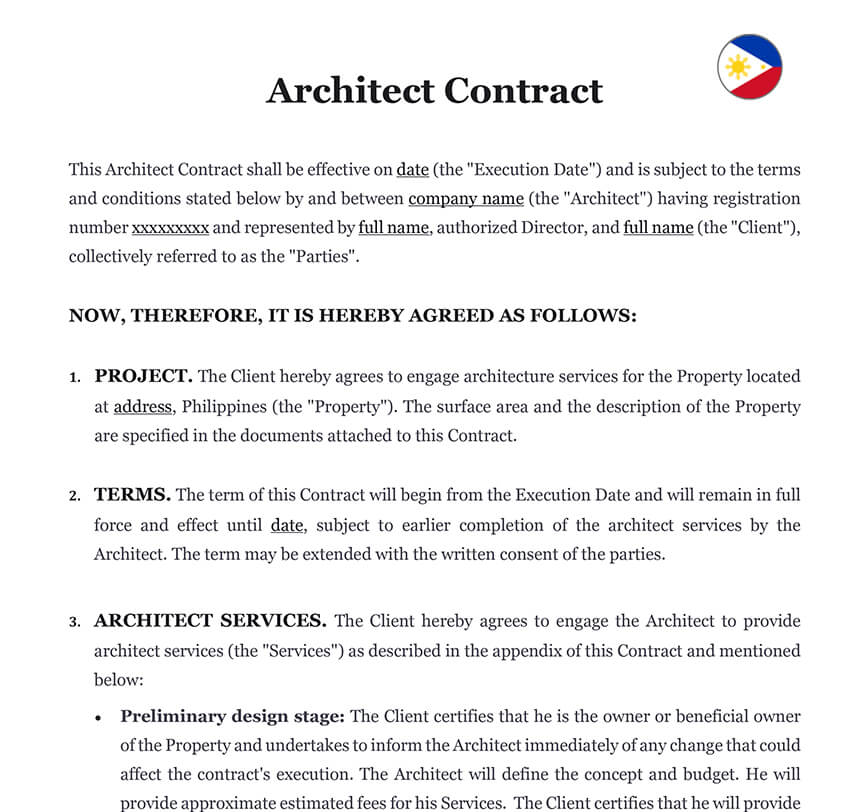Ready to use legal template
Drafted by experienced lawyers
Compliant with Filipino law
Ready to use legal template
Drafted by lawyers
Compliant with Filipino law
Home › Buy a property › Architect contract
Learn more about Architect Contract in Philippines
An Architect Contract defining the nature and scope of the architect’s tasks or interventions, and the terms of his remuneration. The responsibility of the architect is to be involved in all phases of the creation and construction of the space. In general, he is responsible for the management of the project. Download this Architect Contract template that contains all necessary clauses to protect you when carrying out an expensive real estate construction project. You can also download the Real Estate Purchase Agreement, the Construction Contract or even the Interior Design Contract depending on the nature of the work to be carried out.
Table of contents
What is an Architect Contract?
A legal agreement that defines the obligations and rights of the parties involved in a construction project is known as an Architect Contract. A detailed agreement between a corporation or developer and an architect is required.
An Architect Agreement guarantees that all parties understand what is anticipated, who will do what, how long the project will take, how much it will cost, and when it will be completed. Before work begins, it is also vital that all parties understand any deadlines or the procedure for scope revisions.
What is included in the Architect Contract?
Your Architect Agreement should explicitly specify all of your project’s terms, duties, parties, and deliverables. To accomplish so, you must develop a comprehensive document that includes all of the necessary sections.
The parties and project details
Your Architect Agreement’s cover page is created to identify each party participating in the contract. It is intended to serve as an introduction to the project (s).
In general, this area of the contract is where you would create a connection and your purpose to work with a customer or organization. It’s also a good idea to include the contract’s start date as well as both parties’ contact details, such as their address and phone number.
The list of services
You may wear multiple hats as a freelance architect, but that doesn’t imply you provide full-service solutions to all of your customers. As a result, you must properly document all of the services for which you are exclusively accountable. To ensure client satisfaction at the end of the project, we recommend you to be as transparent as possible.
As vital as it is to provide a list of the services you will give, it is as necessary to clarify the services you will not provide. Clients that want you to accomplish things outside of your architect’s scope are not unusual. You can escape any duties you weren’t compensated for if you mention the services you don’t provide.
The architect’s fees
Take the time to cover your rates and costs to ensure that you are fairly compensated. This area of your documentation should not only provide quantities, but also how you charge your client. Do you provide financing? Will you bill by the hour or by the project?
If you pick a fixed fee per project, your overall rate should be determined by the amount of time you expect to spend on the assignment. Remember to factor in the cost of supplies! While this strategy is sometimes the easiest, contractors may lose money if they underestimate their time.
When an architect charges by the hour, they must keep detailed records of every time spent on projects. This guarantees that proper remuneration is provided even if the project takes longer than anticipated. This strategy, though, may cause you to exceed a client’s budget, so you should disclose expected expenses in any situation.
The architect project's timeline
Your project timeframe is the next item to put in your architect agreement. When you take the time to construct a clear timeline for all of your projects, you can keep track of the schedule and progress for both sides.
While it may be tempting to write an attractive schedule in order to obtain a contract, you should also be realistic in order to avoid disappointment or disagreements. The creation of an accurate chronology is more vital. You can do so by thinking about:
| ➤ Architecture Services |
| ➤ Your Schedule for Freelancing |
| ➤ The Project's Purpose |
| ➤ Your Boundaries |
| ➤ Potentially Extenuating Circumstances |





